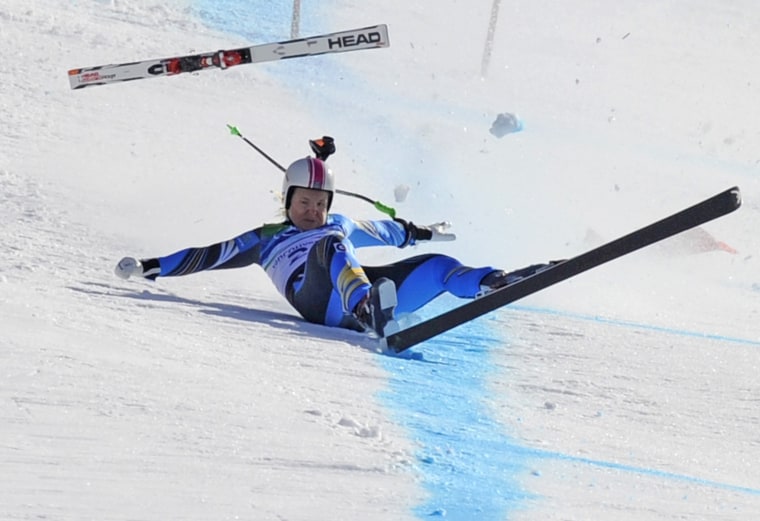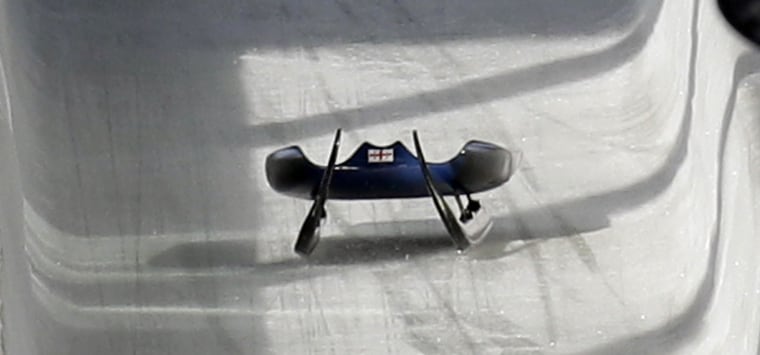With a death on a terrifyingly fast sliding track destined to be a legacy of the Vancouver Games, Olympic officials are looking for a way to balance their motto of "citius, altius, fortius" with the critical element of safety.
"People say the more danger, the better. This is stupid," said Rene Fasel, who headed the IOC's coordination commission for Vancouver. "Safety of athletes must be the No. 1 priority. ... We have to put limits."
The death of luger Nodar Kumaritashvili in a training run, hours before the Olympic flame was even lit, not only cast a pall over the games, but sparked a hard-edged debate that followed. At its center is the question of how far to push the envelope.
The International Olympic Committee and sports federations conduct safety reviews after each games. This time, there literally was a post-mortem, too.
There have been roughly 30 luge and bobsled crashes on the Whistler sliding course, inflicting several injuries and prompting two Swiss bobsled teams to withdraw. The women's Alpine downhill course unnerved some of the world's best skiers and left others dazed after bone-jarring spills.
Hurtling down mountains at breakneck speed, soaring off ramps for triple backflips and flying down chutes of ice at nearly 100 mph all have one thing in common — danger. Yet some argue that the risk factor is crucial to the appeal of games.
Looking ahead to Sochi
Almost immediately after these Olympics end next Sunday, the IOC will begin weighing all arguments and listening to all sides and decide how to move forward, well past the next winter carnival in Sochi, Russia, in 2014.
Under most scrutiny is the International Luge Federation, which has blamed the fatal crash on human error rather than the track. It hopes to release its in-depth safety findings by the end of March.
"Something good has got to come out of this tragedy," former Canadian Olympic luger Chris Wightman said. "There's new ideas. There's so much to think about and reconsider."
Those who know and love the sports in question already are brimming with opinions: Tighten qualification standards to weed out unprepared athletes; require a hefty minimum number of training runs; slow down the sliding tracks.
The Sochi track isn't built yet, but organizers already said that it is designed to be 6-9 mph slower than the one in Whistler and that course safety will be monitored via 3-D computer simulations.
"We will learn from this tragedy," said Dmitry Chernyshenko, head of the Sochi organizing committee. "We are creating additional safety factors to avoid any unexpected problems. Safety is the most important factor."
Increasing the cost of error
Indeed, IOC medical chief Arne Ljungqvist questioned the very logic behind the drive for speed in sliding and skiing.
"It's different from track and field where there have been attempts to make speedy tracks," he said. "In these events, there are no records registered. ... The competition would be just as fascinating with lower speeds and lower risks.
"We are concerned about the tendency that there seems to be increased speed in all these speed events," he said, "and it increases the dangers. The higher speed you have, the smaller is the margin to correct any mistakes."
The IOC has taken numerous safety steps over the years — lowering the obstacles in the three-day equestrian event, requiring protective headgear in boxing and hockey, setting tougher qualification standards to preclude another "Eddie the Eagle," the British plasterer-turn-ski jumper who barely got airborne in the 1988 Calgary Games.
However, Fasel said even tougher screening may be needed.
"On one side we want to be global and universal," he said. "How far do we go? Who do you accept? In team sports, qualification is simple, but in individual sports there must be a limit.
"If some federations do not, we might have to be the ones to put the limit."
Too easy vs. too dangerous
Debates over safety have flared often in previous games — sometimes with the athletes divided among themselves.

Some top women hockey players with the powerful U.S. and Canadian teams would like the freedom to check, as the men do, but accept the kinder-and-gentler rules as necessary to help spread the sport in countries where hockey has no roots. Similarly, top female skiers at some past Olympics have complained that the downhill courses were too easy — in contrast to what some judged to be too dangerous this year.
The Vancouver women's downhill was marred by several spectacular crashes, including one that badly bruised five-time Olympic medalist Anja Paerson of Sweden. The most dangerous jump on the course wasn't shaved down by officials until after the race, even though skiers had known beforehand of its perils.
"It doesn't take people wrecking off it to know it's dangerous," said Thomas Vonn, husband of downhill champion Lindsey Vonn. "Obviously, it's downhill racing and it's always going to be dangerous. But you can minimize risk before it turns into a disaster."
Keep the unprepared out?
Cesare Vaciago, chief executive of the 2006 Turin Olympics and also a member of the IOC's Sochi coordination commission, said national Olympic committees should be more vigilant in keeping unprepared athletes out of the riskiest events.
"It's hard to extend to organizers the task of saying 'This guy cannot race in luge,'" Vaciago said. "The NOCs must put more severe standards on participation."
Canadian Olympic Committee CEO Chris Rudge agrees, saying world-class athletes in risky sports are apt to push themselves to extremes in the quest to win, leaving safety measures in the hands of those who oversee their sports.
"The athletes are not going to hold back, if he or she is in a competitive environment and has to beat somebody else," Rudge said. "So there's a certain incumbency on the regulatory bodies to make sure when the athletes push as hard as they can, they're doing so in an environment that's provided every possibility for safety."
But he also said: "If you really dumb down the track too much, to let everyone in, then you're going to diminish the thrill of the pursuit of excellence."
Wightman, an analyst for Canada's CTV network, said officials should insist that luge competitors actually make every practice run offered them and — if appropriate — acclimate themselves slowly to tracks that are unfamiliar.
"There were times in my career where I was scared," he said. "We've all had that fear — not necessarily knowing how to deal with a new track. There's a very methodical way you learn the track — you start low and move up curve by curve. It's not your right to be at the top of the track."
Wightman also suggested the luge fields could be reduced — for example, paring the men's field from 40 to 30.
Bob Storey, president of the International Bobsled and Toboggan Federation, said he wants to wait for the competition to finish before settling on issues to tackle in his review. But he has voiced frustration at the controversy over the Whistler track — and whether there had been enough early warnings about it to warrant modifications before the games.
"Everybody knew this was a challenging track — all new tracks are," Storey said. "But it's certainly not the most dangerous."
"At the Olympic games, people for many different reasons decide they do or don't like things," he added. "When the track first opened, lots of coaches who didn't know how to coach here yet would mumble and grumble. Then people go down, people get used to it. In the end, the athletes usually love it — but there might be some who don't like it."
Balancing challenge against danger
Looking ahead, Storey said track designers need to strike a fine balance — creating challenges but not excessive danger.
"It's our responsibility to set criteria," he said. "And we have to be careful that people coming to the track have enough experience to deal with it."
One example is 56-year-old Venezuelan luger Werner Hoeger. A veteran of two previous Olympics, Hoeger injured himself in a crash on the Whistler track in November and complained that it was too dangerous. However, there was sentiment in luge circles that an athlete of Hoeger's age shouldn't be used as a safety barometer.
The man who designed the Olympic luge course, Udo Gurgel of Germany, told Sports-Bild magazine that perhaps track walls should be raised by more than a foot on future courses. But making a risk-proof course may not be possible.
"To make it 100 percent safe, you'd need to put the track in a tube, and that's really not what the sport is about," said Tim Gayda, director of sport for the Vancouver Organizing Committee.
No warnings before the games
VANOC has noted that more than 30,000 luge, bobsled and skeleton runs were made on the Whistler track before the games, with neither of the two federations issuing public danger warnings.
Some national teams complained that their sliders were not accommodated by Canada for an adequate number of training runs in the weeks and months before the games. The Canadians, however, said they abided by all federation rules on track access.
Gilbert Felli, the IOC's executive director of the games, said the customary route for conveying athletes' safety concerns is through meetings with team captains — "and they have not done it."
Meantime, one person who vows to do everything possible to prevent another tragedy at the games is the man in charge of it all.
"There is one thing that is certain," said IOC president Jacques Rogge, referring to Kumaritashvili's death. "I will do everything in my power that this should not happen again in the future."
